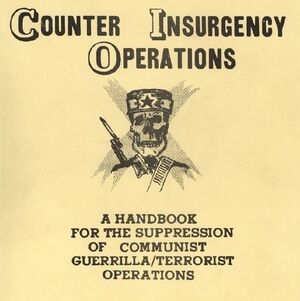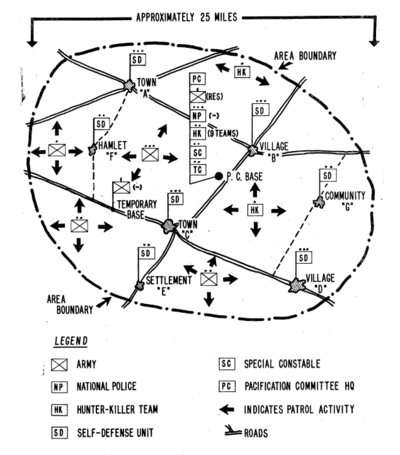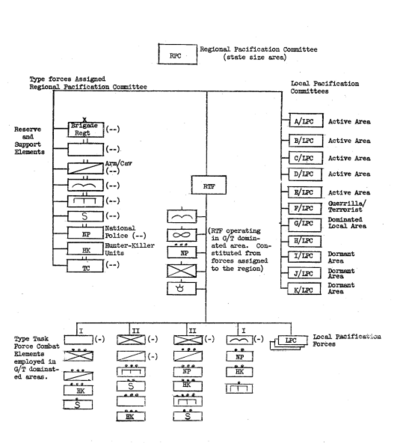A Handbook for the Suppression of Communist Guerrilla/Terrorist Operations (Chapter VI)
| Author | Department of the Army |
|---|---|
| Country | United States of America |
| Subject | Counterinsurgency |
Publication date | 1961 |
| Text | A Handbook for the Suppression of Communist Guerrilla/Terrorist Operations online |
| Digital Identifier (JFK Library): JFKPOF-080-014 | |
| Part of a series on |
| Counterinsurgency |
|---|
ORGANIZATION AND CONDUCT OF OPERATIONS
The conduct of punitive operations in the guerrilla/terrorist suppression campaign is primarily a military activity supported by police, para-military unit, and civil agencies. a. Roles and Missions.
(1) Army: Performs primary role of seeking out and destroying the guerrilla/terrorist military formations at all levels. Provides units to serve under the command of pacification committees at appropriate levels. Provides training, organizational and logistical support to other elements as required.
(2) Naval, Air Forces and Border Guards: Provide coastal, air and border security as necessary. Perform logistical support, surveillance, resupply and training missions as appropriate. Units are assigned or attached to and controlled by pacification committees at appropriate levels.
(3) National Police or Civil Guard units:
(a) Description: Uniformed, armed police personnel generally organized on a platoon basis for country-wide operations.
(b) Roles: Perform police and internal security duties in nonurban areas. Exercise law enforcement, intelligence and counter-subversive duties as directed by pacification committee at appropriate level. Support Army units in punitive actions and relieve Army units of internal security duties in pacified areas.
(4) Municipal and Local Police: Armed uniformed civilian police function in normal law enforcement mission and support operations of local pacification committee.
(5) Civilian Self-Defense Forces: Armed, non-uniformed rural militia, organized at the town, village and hamlet level and trained by the Army to combat indigenous dissident activity* protect local targets, provide guides, surveillance and local contacts and otherwise support operations in in the area. Note: The importance of the role played by well-trained and organized local self-defense forces should be emphasized. The basis for a large proportion of the punitive actions conducted will be dependent on intelligence, combat contracts or other services provided by these forces. The psychological effect of these local civilian inhabitants in the role of part-time soldiers capable of preventing casual communist occupation of the outlying villages and localities materially assists the government in securing the support of the population as a whole. Former military and police service personnel should be utilized to form cadres for those units whenever feasible.
(6) National Intelligence/Security Agencies: Perform intelligence operations against guerrilla/terrorist organizations and counter-subversion/ intelligence functions within government and civil population as directed by appropriate level pacification committees.
(7) Special Police: Recruited and trained for special task. Often possess special skills or aptitudes. These personnel are recruited from the indigenous population and are assigned and utilized as required.
(a) Trackers
(b) Hunters-poachers
(c) foresters or game keepers
(d) Dog trainers and handlers
(e) Primitive indigenous personnel from sparsely populated areas with specialized area knowledge or utilization.
(f) factory, mine, plantation/ranch and railroad guards. Organized to control installation self-defense elements in critical facilities.
(8) Special Intelligence Personnel: Utilized for intelligence, counter-subversion and Psychological purposes; includes but not restricted to:
(a) Agents (b) Informants
(c) “Galvanized Guerrillas'' (reformed enemy personnel working for the government)
(d) Smugglers
(e) Black market operators
(f) Captured red personnel
(g) Defected red personnel
(9) Hunter-killer Teams:
(a) Description: Specially selected and trained teams composed of volunteers from area military and police units augmented by trackers and/or guides. Personnel wear local indigenous civilian clothes or nondescript military attire and possess items of Red insignia on uniforms for use when appropriate. Heavily armed and lightly equipped teams operate in the "brush" without physical contact with the indigenous population for periods of i-3 weeks. Teams establish daily radio contact with local base and are supplied by cache or air drop. Teams are infiltrated into area of operations (land, sea or air) and controlled by local pacification committee. (Size 5-15 personnel). Tracker and patrol or sentry dogs are frequently employed by the team.
(b) Mission: Hunt down and destroy elements of local guerrilla/ terrorist armed bands. Establish and maintain contact with large formations until arrival of reinforcements. Harass and disrupt guerrilla/terrorist units by ambush and capture of couriers, scouts and small groups, booby trap trails and camp areas, destroy supply caches and maintain surveillance over suspected guerrilla rendezvous and assembly areas.
(c) The following type team organization is offered as an example only. Composition will vary considerably with area of operation. Organization of a type 12 man hunter-killer team:
| Job | Type Personnel | ||
|---|---|---|---|
| Team Leader | Army Officer | ||
| Asst. Leader | Senior Army Sgt | ||
| Intelligence (NCO & Assist.) | National Police 3gt | ||
| Intelligence Interrogation & local indigenous contact | National Police Patrolman | ||
| Radio Operator | Army enlisted | ||
| Medic | Army enlisted | ||
| Tracker | Special police | ||
| Dog Handler | Special police | ||
| Action element (4) | Army enlisted | ||
| 2 Tracker dogs | |||
| 2 Patrol/sentry dogs |
(10) Aerial Combat Reconnaissance Company,
(a) The Aerial Combat Reconnaissance Company is a well-balanced team capable of delivering both aerial and ground fire. It has an armed aerial reconnaissance platoon, aerial infantry platoon, air mobile in armed helicopters, a high proportion of automatic weapons and possesses a ground-to-ground and an air-to-ground capability utilizing machine guns, aerial cannon and rockets.. The organic helicopters permit highly maneuverable mounted attack with reduced vulnerability to small arms fire delivered by ground elements. Because of its mobility, firepower and flexibility, the aerial combat reconnaissance company readily. lends itself as a valuable adjunct fo the type of combat conducted in anti-terrorist/guerrilla operations.
(b) Organization is as follows:
1. Co Hq: Tactical Command and Control
2. Aerial Recon Platoon
3 Recon flights of 4 armed helicopters each.
Total 12. Crew - 2 per helicopter. Functions of the platoon are aerial reconnaissance, security and the destruction of enemy forces. Each helicopter crew is capable of independent operation or in any combination of from one to four helicopters. Normal employment will be in teams of two.
3. Aerq Infantry Platoon, The aero infantry platoon consists of a platoon headquarters, three battle teams and a fire support team, mounted in three armed transport helicopters and a support copter armed with MG's and rockets. Mission close with enemy and destroy by fire and maneuver.
4. Aero Weapons Platoon: Consists of three flights of two helicopters each. Total six copters, Three copters are armed with 30 and 50 caliber machine guns and a 1.5' -3.5" aerial rocket system. All are armed with 20 mm cannon and a 4"-6" rocket system. The mission of the Aero Weapons Platoon is to provide air-to-ground fire support.
5. Headquarters and Service Platoon performs administrative and service support to the company.
(c) Because of the technical training and equipment involved, considerable time is necessary to train this type of unit and it may not be available in the early stages of a suppression campaign unless previously organized.
(d) Provisional units, similar to the above may be improvised as an interim emergency measure. Utilizing transport helicopters available and substituting fixed wing-light aircraft for the reconnaissance and fire support helicopters operations may be conducted while regular units are being formed, equipped and trained. Such provisional units will, of necessity, operate with considerably less efficiency and flexibility than the regular all-helicopter unit.
(e) The Aero Combat Reconnaissance companies will normally be assigned to the Regional Pacification Committee and attached in whole or part for specific missions to local committees or regional task forces.
b. Organization and Functions
(1) Command and operational control of combat unit:
(a) Pacification Committees at the national and regional levels determine the assignment of all forces.
(b) The major portion of combat actions occur at the local level and are directed by the local pacification committee.
(c) The regional pacification committees direct the local committees, but only assume direct command of military forces in the conduct of operations against large military formations of guerrilla/terrorists whose activities encompass several subordinate local areas and are beyond the capability of forces assigned at that level. Special commands may be established by the region for the conduct of such missions.
(2) Assignment of Forces: Appropriate forces will be assigned to meet the specific requirements of the area involved. Wide variations will exist within any given area. General considerations are:
(a) Army units suitable for general assignment include infantry, airborne, armored cavalry and engineer units.
(b) Assignment or employment of forces in units larger than battalion size will be the exception. Operations will generally be conducted by squad platoon or company-sized formations.
(c) The employment of artillery, tank or motorized units in an active role in suppression activities, will be usually restricted to infrequent use in large-scale operations.
(d) Military aviation, including fixed and rotary wing aircraft, plays an important role in reconnaissance liaison, surveillance, fire support, communications, resupply and evacuation.
(3) Schematic type local pacification committee task force structure (area one to two county size):
(a) Type local pacification committee task force:
2 Rifle Co's Inf Regt Amy
1 National Police Platoon
4 Hunter-killer Teams
1 Special Police Section (10 men) Trackers and Dog handlers. Kennel of trackers and sentry/patrol dogs.
1 Transportation Corps Truck Section (12 trucks)
4 Self-Defense Platoons (13-30 men each located in villages and towns)
3 Self-Defense Sections (3-15 men each located in 3 local hamlets)
Aircraft are assigned as required for specific missions.
(b) Type local pacification committee command and staff:
Commander - Battalion executive officer of the infantry battalion furnishing '2 rifle companies.
Deputy - Public prosecutor of the district government (reserve officer)
District Representative - Mayor of town in the area, represents local civil agencies and populace.
Personnel Officer - 1st Lt, Inf Bn.
Intelligence Officer - National Police Captain
Asst Intel Officer - Civilian from Nat'1 Security Agency
Operations Officer - Captain, Infantry Battalion
Asst Operations Officer and Air Liaison Officer
Public Policy and Information Officer - Civilian or military representative of Psychological Operations
Supply Officer - 1st Lt, Infantry Officer
(c) Schematic Deployment of Pacification committee force in a type locale: (on following page).
(4) Type task allocation of local pacification committee task force (see sketch schematic deployment).
(a) One rifle company in reserve at pacification base. Exploits, contacts or counters enemy action. Supports national police platoon in search and security operations.
(b) One rifle company on patrol operation from temporary CP with two platoons engaged in actual patrol operations and the company (-) in reserve to exploit patrol contacts. Company remains on patrol duty for periods of 5-7 days and is relieved by the reserve company. Patrols operate with trackers. Trail dogs and sentry patrol dogs are employed where, feasible.
(c) Two hunter-killer teams arc on patrol in assigned areas. Duration of patrol 2-3 weeks. Two HK teams are held in reserve for exploitation action and relief of teams on patrol. Trackers and dogs are attached as in (b) above.
(d) Special police are assigned to patrol elements as trackers and dog handlers, as required. Reserve is maintained at PC Base.
(e) Self-Defense Units: Man local outposts in villages and towns, engage in periodic around-the-clock perimeter patrols of the community and maintain local alert force available for defense missions. One Army NCO and 2 National Police assigned to each platoon size SD unit. Sentry/patrol dogs when available are attached to self-defense units.
(f) National Police Platoon: Supervises convoy and road traffic security. Operates search and check points. Conducts house raids and searches. Conducts interrogation of suspects and operates local confinement facilities. Generally operate in 3 man teams supported by military personnel as required. Dogs are employed as necessary, for sentry and trailing purposes.
(5) The local pacification committee exercises command from a central command post base in the area. The local Pacification Committee Command, staff and operational units are organized and operated as a 24 hour a day, seven day a week integrated combat command. Stress is placed on efficiency, speed and bold action based on prompt decisions and current intelligence.
(a) Temporary forward command posts are set up as required for the direction o£ specific operations.
(b) All intelligence flows into the command post and is rapidly disseminated to the echelons concerned. Control of informants, agents and other personnel engaged in penetration or surveillance of guerrilla/terrorist operations is exercised by the Intelligence Officer.
(c) Immediate on-the-spot interrogation of all captured personnel is initiated by captors to exploit current operations and maintain contact with guerrilla/terrorist formations. Results are relayed to CP while operation is in progress.
(d) Requests for assistance, interception, air support or transport are coordinated and controlled by the local pacification committee (LPG) command post. Maximum utilization is made of air for both visual and photographic reconnaissance. Commanders of all echelons are encouraged to use available aircraft for personal reconnaissance.
(e) Aircraft are normally controlled by the regional/provincial commands and placed under, the operational control of local committee for specific operations.
(f) Areas in which hunter-killer teams and patrols arc operating are carefully coordinated to avoid inadvertent clashes between friendly units. Peculiar pre-arranged audio and visual signals are employed by patrols and other formations to establish identity of friendly forces in doubtful situations. Lateral radio contact between patrols is established when contact with them is imminent or probable. In doubtful cases the patrol or other formation, when feasible, should contact PC Base for a spot, location report on friendly units. Patrol should seek clearance and direction from PC Base before attempting to enter villages or other; patrolled areas.
(g) All contacts with guerrilla/terrorists are reported immediately to local pacification command.
(h) Movements and sightings of guerrilla elements are reported immediately and intercept, ambushes on routes, possible assembly areas and/or targets are plotted.
(i) Maximum use of radios and visual signals are utilised to report, expedite and control operations. Minimum reliance is placed on telegraph, telephone or other: forms of communication susceptible to interdiction or interception by enemy action. Provisions for communication security must be stressed in all operations as the guerrilla/terrorist intelligence apparat will make every effort to disrupt or intercept the security forces communications.
(6) Regional/Provincial Pacification Committee. The mission of the regional/provincial pacification committee (RPC) is to direct and support the operations of the several local pacification committees (LPC) within the region and conduct such operations that are beyond the LPC capabilities.
(a) The following is a schematic organization of a type regional pacification command and force structure in an area of active guerrilla/terrorist operations:


